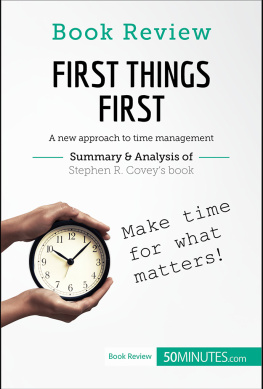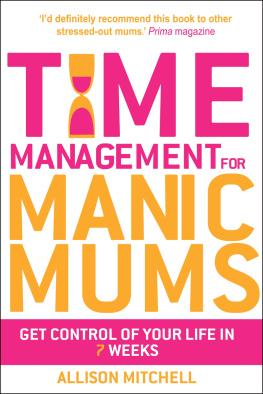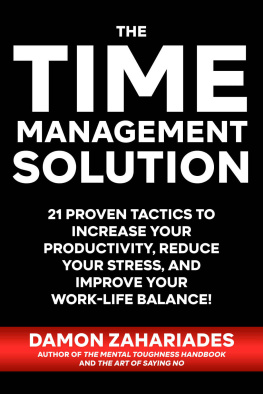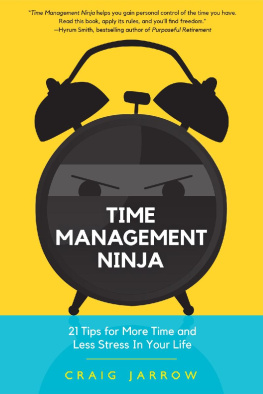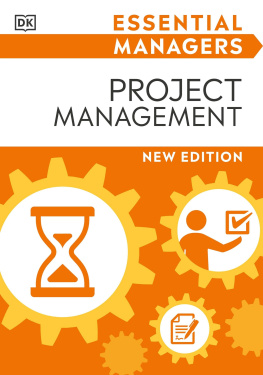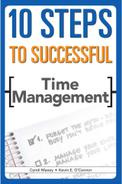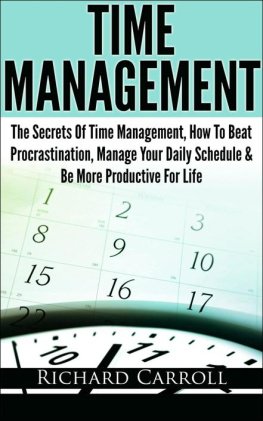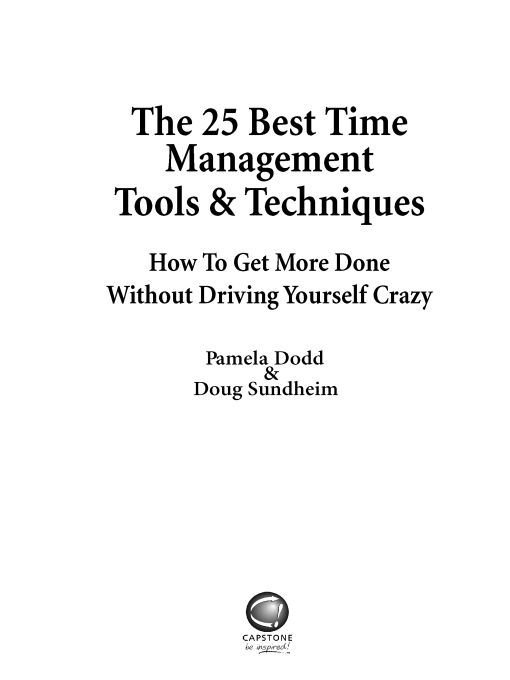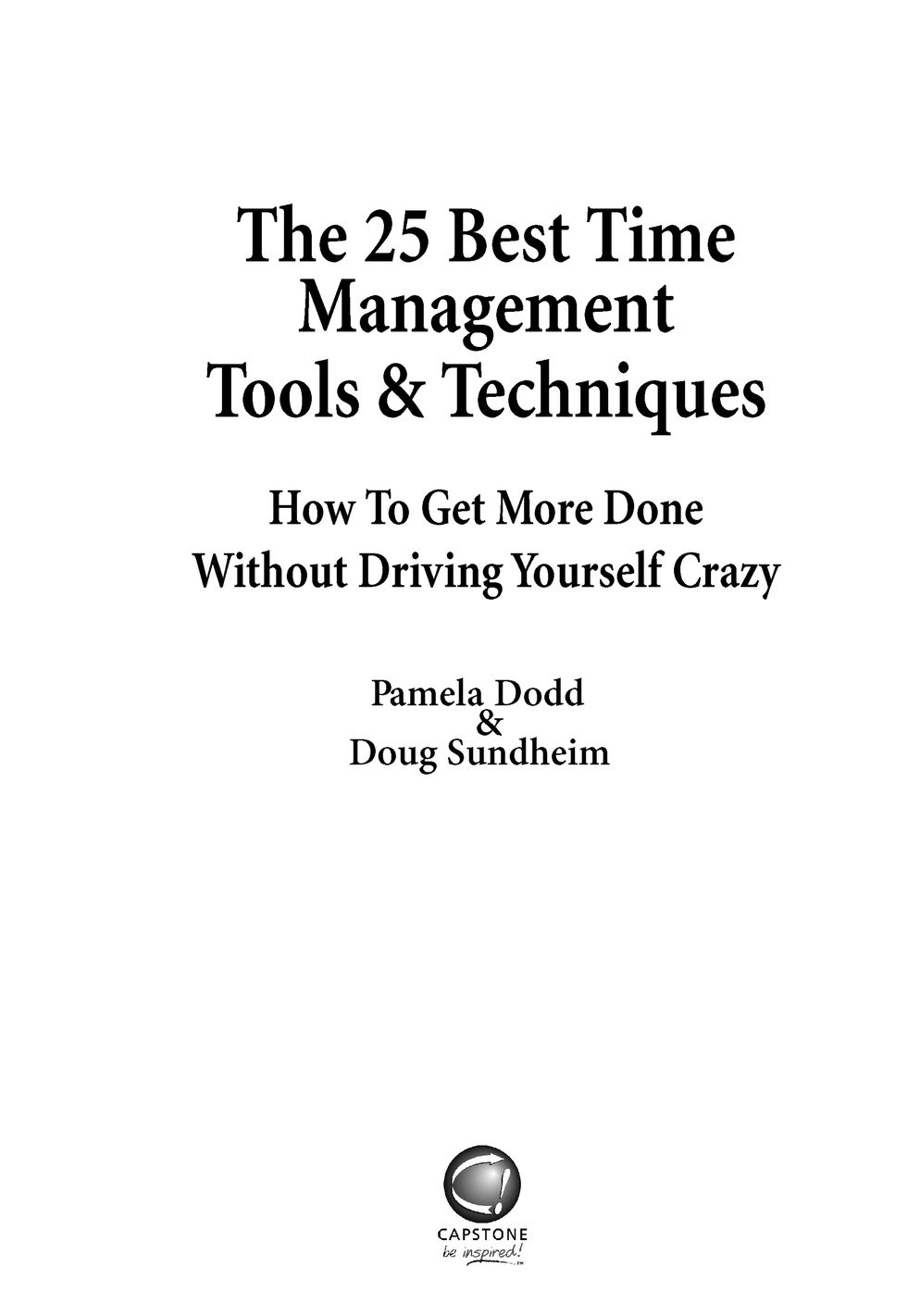Table of Contents
Clear, focused, full of action-oriented suggestions. This is THE new management reference guide!!
ANDREA NIERENBERG, AUTHOR OF NONSTOP NETWORKING
Doug delivers concise, effective advice to his clients. Now, anyone who wants to accomplish more in todays 24/7 world can learn how to do so from a true expert in the art of business productivity.
NATHAN DERBY, MANAGER OF EDUCATION AND DEVELOPMENT, HARVARD MANAGEMENT COMPANY
The techniques in this book definitely made me more efficient and profitable. I was good at what I do. Now Im even better!
SCOTT HENDRICKSON, NATIONAL ADVERTISING DIRECTOR, SPORTS ILLUSTRATED FOR KIDS & SPORTS ILLUSTRATED FOR TEENS
Pams facilitation work with our Board and physicians group was exquisitely powerful, helping us navigate through a difficult transition as a cohesive team. Get this book if you want to live a more enjoyable life with much less stress.
ALLEN KORNEFF, PRESIDENT & CEO, DOWNEY REGIONAL MEDICAL CENTER
At last, a book that brings time management into the 21st Century. This book is contemporary, practical, and well researched. A priceless guide to smarter, better business and living.
ALASTAIR RYLATT, AUTHOR OF WINNING THE KNOWLEDGE GAME
This book hits the nail on the head. Doug and Pam clearly spell out the foundations of success and take people exactly where they need to go. I highly recommend it!
MICHAEL J. BRATHWAITE, EXECUTIVE DIRECTOR, BUSINESS NETWORK INTERNATIONAL FOR NEW YORK CITY
ACKNOWLEDGMENTS
Much of this book was built on the road in the course of running our consulting business. We learned firsthand what works and doesnt work in managing our own time. We also learned that you cant accomplish much without support from others.
Wed both like to thank Michele DeFilippo, 1106 Design, for squiring this book through the publishing process. She was a gem to work with and made book publishing seem easy.
Wed also like to acknowledge the following friends, family, and colleagues:
Pam Kudos to my Internet marketing colleagues. Thanks to Jim Edwards and Joe Vitale for starting me on the book path. Many thanks to Yanik Silver for the time spent on the phone with me. Special thanks to Ken McCarthy and System Club members Elsom Eldgridge, Susie and Otto Collins, and Bettina Mueller. And deep appreciation to Brad Fallon, Andy Jenkins, and StomperNet members. Both learning communities par excellence!
Im also grateful for the interest and encouragement of friends Barry Grieder, Larry Witzleben, Diane DiCarlo, and Melissa Personette. I deeply appreciate the financial generosity of my mother, Peg Hurlbut.
Most of all, I want to acknowledge two important men in my life. Many thanks to my husband, Tom Connellan, for his love and considerable help during this project. A published author himself, he gave me space to do things my own way. Im also grateful for the strong business and personal relationship I have with my co-author, who is also my son. No parent could ask for a more loving, creative connection.
Doug I want to thank several people who helped shape this book, including Mike Van Cleave, Maria Boafo, Nathan Derby, Nancy Donohue, Alex Toia, and Armando Meija.
Many others have encouraged me along the way. Id like to thank Bill Markel for showing me whats possible with dogged determination. Id like to thank Debra Sparks being one of my biggest fans. Thanks also to Jason Bonadio for offering a good ear and sound advice when I needed it. And thanks to my dad, Jim Sundheim, who hasnt always been sure where Im headed but hopes like heck that I get there.
Finally Id like to acknowledge two special women in my life. My girlfriend, Daryn Morgenstein, has been a great help as weve built this business and put these ideas together. And thanks to my mom for a lifetime of support and conversations. In so many ways I wouldnt be where I am now without her.
INTRODUCTION
We all want to be more productive. We also want to have more fun and enjoy life more. These goals arent mutually exclusive. It all boils down to time and how you use it.
Before we tell you a little about this guide, lets be clear on a few basics.
First, fundamental facts about time:
Everyone gets exactly 24-hours a day. No more. No less.
Time cant be owned, borrowed, or saved.
Time is a convenient concept invented to mark our days more precisely than morning, noon, and night. In ancient times it was measured with shadow sticks and sundials. Now we use clocks. Regardless of device, time cant be managed. It passes. Thats it.
What were really managing when we talk about time management is the events of our lives, including the tangible and intangible stuff connected to these events. For conventions sake, however, well call it time management like everyone else.
Second, you are at the center of how time occurs for you. Contrary to popular belief, time management doesnt change things out there. It changes you and your relationship to things out there. Successful people know this and use it to their advantage. So can you.
The benefits of good time management are considerable. People who manage their time well:
Get more done
Feel less stress
Have better relationships
Feel better about themselves and their lives
Have ample time to do the things they like to do You can have all that too. Its up to you.
What makes this guide different from other time management books is its breadth and brevity. It covers the whole range of time management topics in a short, to-the-point fashion.
Weve loaded the guide with the best available information on time management. Our strategy for finding this information was simple. We read the Amazon.com customer reviews for over 40 time management books. Then we bought and read the top 20.
A word about Amazon reviews. We realize that authors friends and family often write many of the favorable reviews. However, no books worth their salt can survive solely on cronyism. Luckily folks who dont like books write reviews too. Plus we formed our own opinions.
The structure of this guide came from the commonalities we identified in the 20 books we read. The 25 Best Tools and Techniques fall into five related areas:
Section I (Focus) shows the best ways to find out whats really important to you.
Section II (Plan) explains the best ways to manage your plans for results.
Section III (Organize) describes the best ways to manage your living and work spaces.
Section IV (Take Action) discusses the best ways to manage your actions.
Section V (Learn) covers the best ways to continually improve.
How you use the guide is up to you. Read it from start to finish or zero in on specific areas. Since no time management system is right for everyone, weve included many options. If one solution doesnt work, try another. Do something. Anything. If you just read, you wont manage time any better than you do now.
Remember, changing a lifetime of habits takes time, sometimes as long as a year or two. Be patient with your efforts to manage yourself better. Your ultimate reward is the life youve always wanted to live.



